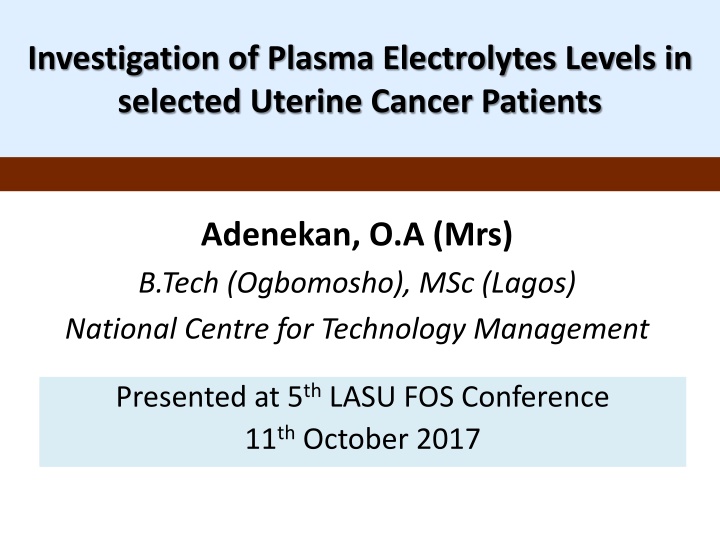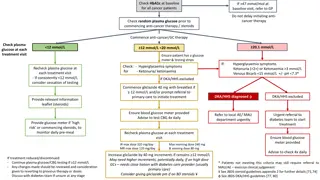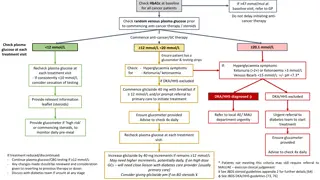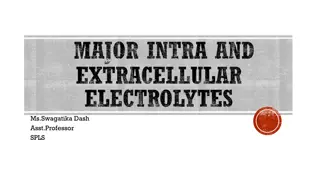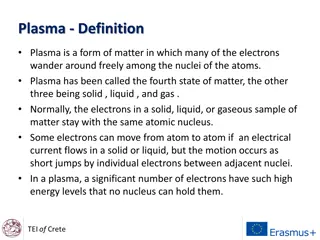Plasma Electrolytes Levels in Uterine Cancer Patients Investigation
This study explores plasma electrolytes levels in uterine cancer patients to understand potential correlations and implications for diagnosis and treatment. Uterine cancer, a common gynaecological cancer, poses significant risks primarily affecting women aged 55-64. Electrolytes play vital roles in the body, influencing various physiological functions such as nutrient transport, fluid balance, pH maintenance, and muscle activity. The investigation aims to shed light on electrolyte imbalances in uterine cancer patients and their impact on health outcomes.
Download Presentation

Please find below an Image/Link to download the presentation.
The content on the website is provided AS IS for your information and personal use only. It may not be sold, licensed, or shared on other websites without obtaining consent from the author.If you encounter any issues during the download, it is possible that the publisher has removed the file from their server.
You are allowed to download the files provided on this website for personal or commercial use, subject to the condition that they are used lawfully. All files are the property of their respective owners.
The content on the website is provided AS IS for your information and personal use only. It may not be sold, licensed, or shared on other websites without obtaining consent from the author.
E N D
Presentation Transcript
Investigation of Plasma Electrolytes Levels in selected Uterine Cancer Patients Adenekan, O.A (Mrs) B.Tech (Ogbomosho), MSc (Lagos) National Centre for Technology Management Presented at 5th LASU FOS Conference 11th October 2017
Outline: Introduction to study Uterine cancer: overview Electrolytes: Na, Cl-, K+, HCO3, PO43- Methodology Results Discussion Conclusion
Introduction Uterine cancer is globally acclaimed as the sixth most common cancer in women. It is the most frequently diagnosed gynaecological cancer among women (aged 55-64 years) And the next rated cause of cancer death among women (after breast cancer) in Nigeria.
Uterine cancer: What happens? This malignancy develops when normal cells in the uterus or womb suddenly change and grows uncontrollably due to loss of regulation, forming a mass called tumor. Hence, this may develop in cells lining the uterus (endometrium) as endometrial hyperplasia and in muscle or other tissues of the uterus as uterine sarcoma
IntroContd The diagnosis of uterine cancer is generally presaged by abnormal uterine bleeding. In premenopausal women this may present as bleeding between menses or menses which are heavier than usual, pain during urination and sexual intercourse. The risks for uterine cancer are enormous and thus include age, diet, heredity, obesity, diabetes mellitus, breast cancer, use of tamoxifen, late menopause, high levels of oestrogen, pelvic radiation and ethnicity.
Electrolytes: What? They are electrically charged minerals that can be found in body tissues and blood in the form of dissolved salts capable of performing specific physiological functions And thus, they exist within a narrow concentration range in order to express their physiological functions.
General functions of electrolytes Their general functions are worthwhile in that they aid the movement of nutrients into and wastes out of the body's cells, maintain a healthy water balance and pH level of body s fluid and are responsible for muscle functions and other important processes in the body.
Electrolyte Imbalance A value higher or lower than the normal range is referred to as electrolyte imbalance. electrolyte disorders are commonly encountered in patients with cancer and can be secondary to either the cancer itself or its therapy. uncorrected electrolyte abnormalities may have a life-threatening sequelae such as kidney failure, paralysis, seizures, coma, intractable nausea and vomiting, diarrhoea, and even death
Why this study? In view of the physiological functions of electrolytes in human body and the need to recognise the cause of fluid and electrolyte abnormalities while making treatment decisions, this study was undertaken to investigate the comparative level of plasma electrolytes in patients with uterine cancer against normal subjects (healthy individuals) using appropriate standard methods to estimate the electrolyte level.
METHODOLOGY This case-controlled comparative study was carried out in the department of chemical pathology, Obafemi Awolowo University Teaching Hospital (OAUTH), Nigeria. The patients consent was sought before recruitment into the study. Twenty (20) freshly diagnosed uterine cancer patients (aged 45 65 years) confirmed by biopsy and with no other medical complications apart from uterine cancer were selected by convenience sampling. Twenty (20) age-matched uterine cancer-free and healthy volunteers (all females) were used as controls after exclusion of the disease by history and clinical examination. None of the patients or control subjects was on phosphate, calcium, sodium, chloride, bicarbonate and supplements.
Collection of Blood Samples 10 ml of venous fasting blood samples of each of the subjects in each of the subject groups were drawn into lithium heparinised anticoagulant bottle. The blood samples collected were promptly centrifuged at 4000 revolution per minute for 5 minutes to separate plasma from serum. The sputum of each of the subjects in each of the subject groups were collected in a sterile universal bottle.
Estimation of electrolytes: Sodium: A method of Teri et al (1958) using flame photometer Potassium: a method of Teri et al (1958) using flame photometer Phosphate: a method described by Bell and Dolsy (1920) Chloride: a method of Skeggs and Hochstrasser (1964) Bicarbonate: titration method described by Van Slyke
Data Analysis Statistical differences among blood plasma electrolytes between study group and control subjects were determined using a two-way ANOVA. The multi-comparison analyses were done using Turkey posthoc test at p<0.05, p<0.01 and p<0.001. All analyses were performed with Graphpad 7 software.
Results: Figure 1 shows the results for comparison electrolytes level (PO43-, Cl- ,Na+, K+,HCO3-) in the blood plasma samples (mmol/L) of uterine cancer patients and healthy individuals. There was a significant increase (P<0.05; P<0.0001) in the level of PO43- andNa+ in uterine cancer patients as compared to the control group respectively. However, there was a significant decrease (P<0.05; P<0.0001) in the level of Cl- andHC03- in uterine cancer patients as compared to the control group. There was no significant difference (P>0.05) in the level of K+ in uterine cancer patients as compared to the control group.
Discussion: Plasma electrolyte values are usually indicative of the renal functions or dysfunctions. The result of this study has shown that women with uterine cancer have higher plasma phosphate levels when compared with the control subjects. This findings is however different from a similar study on breast cancer patients conducted in Nigeria ((Usoro et al, 2010). But hyperphosphatemia and inositol polyphosphate phosphatise (phosphate-enriched enzyme) has also been reported present in other malignancies (Benjamin et al., 2014; Tsouko et al, 2014).
The above observation can be attributed to the fact that in cancer cells there is an uncoordinated cellular metabolism that could lead to cell invasion or gradual destruction of healthy cells and therefore leading to the influx of PO43- from the cells to the plasma. Thus, abnormal (PO43-) levels are related to development of cancer (Guyton and Hall, 2006). Under physiological conditions, most of the Na+ is reabsorbed in the proximal tubule of the kidney (Guyton and Hall, 2006).
Discussion contd: Sodium increase: The same reason for the significant increase of plasma phosphate levels as stated above also holds for the significant increase in sodium level in uterine cancer patients as compared with control subjects. Hence, there is tendency for patients with malignancy to develop abnormal sodium increase (hypernatremia) if their thirst mechanism is defective or if they are unable to drink (Dafnis and Laski, 1993). This disordered sodium balance is tumor-related and has also be linked to a decrease in true circulating blood volume, sodium absorption interference (causing damage to renal tubules) in a syndrome of inappropriate secretion of antidiuretic hormone (SIADH) (Onitilo et al,2007).
Discussion Contd plasma Cl However, the significant decrease in plasma chloride level in uterine cancer patients against normal subjects could be due to decreased synthesis or altered catabolism of chloride ions in the body which is not uncommon in patients with malignancies. There is increasing evidence that depletion of sodium chloride in the body may exert a serious neoplasmic effect on the renal electrolyte function (Salazar et al, 2005) and that chloride ions can modulate cell proliferation of human androgen-independent prostatic cancer cells (Hiraoka et al, 2010).
Discussion Contd plasma HCO3 Similarly, the significant loss of bicarbonate ions in cancer patients is evident in a recent study (Ching et al, 2014) and can be attributed to the body s compensatory mechanism maintain electrochemical neutrality due to the plasma levels of Na+ and especially chloride (Folaranmi and Adesiyan, 2004).
Conclusion: It was concluded that differences in electrolytes found in uterine cancer patients as compared with healthy individuals may have a great potential as a diagnostic tool in clinical practice. Thus, this study suggests that development of electrolyte abnormalities is likely to provoke symptoms that can negatively affect quality of life and may prevent certain chemotherapeutic regimens.
Recommendations: We therefore recommend a larger study with a greater range of values to further define the strength of this relationship. Further studies in this field should take into account the hormonal and metabolic factors involved in electrolyte metabolism ; and also the role of dietary electrolyte intake, while also addressing the impacts of other cancer-related effect modifiers beyond the coverage of the current study.
References: Tsouko, E., Khan,.A.S White, M A Han, J.J., Shi, Merchant, Y F A , Sharpe, M A Xin, L and Frigo, D.E. 2014. Regulation of the pentose phosphate pathway by an androgen receptor mTOR-mediated mechanism and its role in prostate cancer cell growth. Oncogenesis 3:103. Onitilo, A.A., Kio, E and Doi, S.A.R (2007). Tumor-Related Hyponatremia. Clinical Medicine & Research, 5(4): 228-237 Filippatos, T.D., Milionis, H.J., and Elisaf, M.S. 2005 Alterations in electrolyte equilibrium in patients with acute leukemia. Eur J Haematol 75: 449 460. Folaranmi, O.M. and Adesiyan, A.A. 2004. Comparative study of plasma electrolytes (Na+, K+, Cl-, and HCO3-) and urea levels in HIV/AIDS and pulmonary tuberculosis infected subjects. Biokemistri 16(1):29-36. Salazar-Martinez, E. and Lazcano-Ponce E. 2005. Dietary factors and endometrial cancer risk: results of a case-control study in Mexico. Int J Gynecol Cancer. 15(5):938-945. Yeung, S.J., Sarlis, N.J., Agraharkar, M., Baweja, K., Fahlen, M.T., Khardori, R., Talavera, F. and Thomas, C.P. (2014). The pathophysiology and causes of hyperchloremic metabolic acidoses and renal tubular acidoses (RTAs). Retrieved on www.emedicine.medscape.com/ on 3rd October 2014. Usoro, N.I., Omabbe, M.C., Usoro, C.A and Nsonwu, A. (2010). Calcium, inorganic phosphates, alkaline and acid phosphatise activities in breast cancer patients in Calabar, Nigeria. African Health Sciences; 10(1): 9 -13
THANK YOU FOR YOUR ATTENTION
